본 논문은 한국어의 존칭표현이 공손이론(politeness theory)으로 설명 가능한지를 살펴보고 화용론적으로 Agha(1998)의 언어사용역 이론(enregisterment theory)과 Silverstein(2003)의 단계적 지표성 이론에 ...
http://chineseinput.net/에서 pinyin(병음)방식으로 중국어를 변환할 수 있습니다.
변환된 중국어를 복사하여 사용하시면 됩니다.
- 中文 을 입력하시려면 zhongwen을 입력하시고 space를누르시면됩니다.
- 北京 을 입력하시려면 beijing을 입력하시고 space를 누르시면 됩니다.
https://www.riss.kr/link?id=A100050413
- 저자
- 발행기관
- 학술지명
- 권호사항
-
발행연도
2014
-
작성언어
English
-
주제어
존칭표현 ; 한국어 존칭어 ; 공손이론 ; 언어사용역 ; 지표성 ; 기호학 ; honorific expressions ; Korean honorifics ; politeness theory ; enregisterment ; indexicality ; semiotics
-
등재정보
KCI등재
-
자료형태
학술저널
- 발행기관 URL
-
수록면
573-592(20쪽)
-
KCI 피인용횟수
0
- 제공처
-
0
상세조회 -
0
다운로드
부가정보
국문 초록 (Abstract)
본 논문은 한국어의 존칭표현이 공손이론(politeness theory)으로 설명 가능한지를 살펴보고 화용론적으로 Agha(1998)의 언어사용역 이론(enregisterment theory)과 Silverstein(2003)의 단계적 지표성 이론에 어떻게 부합되는지를 논의한 연구이다. 특히 Brown and Levinson(1987)의 존칭표현과 Hill(1986)에서 주장한 인식의 표현에 근거한 존칭표현을 분석하였다. Brown and Levinson의 존칭표현에서는 존칭표현이 ‘face-threatening act’로 인해 사용된다고 주장되었다. 다시 말해서 존칭표현은 파괴적이거나 부정적인 효과가 있을 때 이를 완화하기 위해서 쓰이는 언어표현이라고 정의하였다. 그에 반해, Hill에 따르면, 존칭표현이나 존대표현은 사회적 지위가 높은 사람에게, 권력이 있는 사람에게, 연장자에게, 그리고 더욱 형식적인 상황에서 쓰인다고 보고 있다.
본 논문에서는 한국어 교사모임 회의에서 나타난 존칭표현인 ‘-시, -께서, 분, 저희, 드리다, -ㅂ니다’를 분석함으로써 한국어 존칭어의 경우 Brown and Levinson의 공손이론이 더욱 적합한 것을 밝히며, 또한 Agha와 Silverstein의 기호학적 언어사용역과 지표성이 한국어 대화에서 존칭표현과 공손표현으로 실현되고 있음을 밝힌다. 이는 한국어 화자들이 존칭표현과 공손표현을 지속적으로 사용하고 있으며, 이는 특정한 지표를 나타내는 지표화된 표현임을 암시한다. 특히 지표성 순서에서 높은 단계인 2-3단계의 지표성을 사용함으로써 한국어 화자들은 존칭표현을 통하여 지위의 높고 낮음뿐만 아니라 지시와 명령의 대면 행위의 부정적인 얼굴 표현을 피하기 위한 수단으로 자유자재로 쓰고 있음을 알 수 있다. 결국, 존칭표현은 단순한 높임을 나타내기 위한 수단이지만 사회적 계층을 나타내면서 동시에 형식적인 면을 표현해 주는 간접적인 2-3단계의 지표가 된다는 것을 보여주고 있다.
다국어 초록 (Multilingual Abstract)
The use of honorific expressions is heavily dependent on the context, and the relationship between the interlocutors. Honorifics are used as a manifestation of discernment(Hill et al 1986, Ide 1989, 2005, 2006, Ide & Yoshida 1999), which means that sp...
The use of honorific expressions is heavily dependent on the context, and the relationship between the interlocutors. Honorifics are used as a manifestation of discernment(Hill et al 1986, Ide 1989, 2005, 2006, Ide & Yoshida 1999), which means that speakers use honorifics to be polite to: 1) a person of a higher social position, 2) a person with power, 3) an older person, and 4) in a formal situation. On the other hand, honorific expressions, as polite expressions in Korean and Japanese, are also used to redress the ‘face-threatening act’(Brown and Levinson 1987). Brown and Levinson argue that ‘face’ consists of two related aspects; positive and negative face. This paper examines which politeness theory can be best applied to honorific uses in the formal setting of a Korean teachers’ meeting and what the honorific expressions index in terms of semiotic symbols. The paper also seeks to find an answer for the questions of how much and how deeply the use of Korean honorifics is enregistered using Agha(1998) and Silverstein(2003).
목차 (Table of Contents)
- 국문초록
- 1. Introduction
- 2. Korean honorific expressions
- 3. Theoretical background
- 4. The study
- 국문초록
- 1. Introduction
- 2. Korean honorific expressions
- 3. Theoretical background
- 4. The study
- 5. Conclusion
- REFERENCES
- Abstract
참고문헌 (Reference)
1 Ide, S., "Wakimae no Goyoron (Pragmatics of Wakimae)" Taishukan 2006
2 Agha, A, "Voice, footing, enregisterment" 15 (15): 38-59, 2005
3 Hill, Beverly, "Universals of linguistic politeness: quantitative evidence from Japanese and American English" 10 : 347-371, 1986
4 Agha, A, "The social life of cultural value" 23 : 231-273, 2003
5 Kockelman, P., "The SAGE handbook of sociolinguistics" SAGE Publications Ltd 165-179, 2011
6 Sohn, Ho-min, "The Korean Language" Cambridge University Press 1999
7 Ide, S, "The Handbook of Japanese Linguistics" Blackwell 444-480, 1999
8 Agha, A, "Stereotypes and registers of honorific language" 27 : 151-193, 1998
9 Brown, P., "Politeness: Some universals in language usage" Cambridge University Press 1987
10 Kim Alan Hyun-Oak, "Politeness in East Asia" Cambridge University Press 2011
1 Ide, S., "Wakimae no Goyoron (Pragmatics of Wakimae)" Taishukan 2006
2 Agha, A, "Voice, footing, enregisterment" 15 (15): 38-59, 2005
3 Hill, Beverly, "Universals of linguistic politeness: quantitative evidence from Japanese and American English" 10 : 347-371, 1986
4 Agha, A, "The social life of cultural value" 23 : 231-273, 2003
5 Kockelman, P., "The SAGE handbook of sociolinguistics" SAGE Publications Ltd 165-179, 2011
6 Sohn, Ho-min, "The Korean Language" Cambridge University Press 1999
7 Ide, S, "The Handbook of Japanese Linguistics" Blackwell 444-480, 1999
8 Agha, A, "Stereotypes and registers of honorific language" 27 : 151-193, 1998
9 Brown, P., "Politeness: Some universals in language usage" Cambridge University Press 1987
10 Kim Alan Hyun-Oak, "Politeness in East Asia" Cambridge University Press 2011
11 Matsumoto, Y, "Politeness as conversational universals: Observations from Japanese" 8 (8): 207-221, 2003
12 Sohn, Ho-min, "Korean" Routledge 1994
13 Goffman, E., "Interaction ritual: Essays on face-to-face behavior" Doubleday 1967
14 Strauss, S., "Indexicality and honorific speech level choice in Korean" 43 : 251-651, 2005
15 Silverstein, M, "Indexical order and the dialectics of sociolinguistic life" 23 : 193-229, 2003
16 Ide, S, "Formal forms and discernment: two neglected aspects of universals of linguistic politeness" 8 (8): 223-248, 1989
17 Ide, S., "Broadening the Horizon of Linguistic Politeness" Benjamins 45-64, 2005
18 Cook, H. M., "Are honorifics polite? Uses of referent honorifics in a Japanese committee meeting" 43 : 3655-3672, 2011
19 Lukoff, F., "An Introductory Course in Korean" Yonsei University Press 1982
동일학술지(권/호) 다른 논문
-
담론과 대화의 수업 모형을 바탕으로 한 한국어 속담 수업 연구
- 강원대학교 인문과학연구소
- 김금숙(Kim, Gum-Suk)
- 2014
- KCI등재
-
- 강원대학교 인문과학연구소
- 이정아(Lee, Jung-Ah)
- 2014
- KCI등재
-
어진박물관의 가치 창출을 위한 태조어진과 6조 어진의 제문제 고찰
- 강원대학교 인문과학연구소
- 김철배(Kim, Chul-Bae)
- 2014
- KCI등재
-
- 강원대학교 인문과학연구소
- 정병국(Jhung, Byung-Kuck)
- 2014
- KCI등재
분석정보
인용정보 인용지수 설명보기
학술지 이력
| 연월일 | 이력구분 | 이력상세 | 등재구분 |
|---|---|---|---|
| 2022 | 평가예정 | 재인증평가 신청대상 (재인증) | |
| 2019-01-01 | 평가 | 등재학술지 선정 (계속평가) |  |
| 2018-12-01 | 평가 | 등재후보로 하락 (계속평가) |  |
| 2015-01-01 | 평가 | 등재학술지 유지 (등재유지) |  |
| 2011-01-01 | 평가 | 등재학술지 선정 (등재후보2차) |  |
| 2010-01-01 | 평가 | 등재후보 1차 PASS (등재후보1차) |  |
| 2008-01-01 | 평가 | 등재후보학술지 선정 (신규평가) |  |
학술지 인용정보
| 기준연도 | WOS-KCI 통합IF(2년) | KCIF(2년) | KCIF(3년) |
|---|---|---|---|
| 2016 | 0.39 | 0.39 | 0.48 |
| KCIF(4년) | KCIF(5년) | 중심성지수(3년) | 즉시성지수 |
| 0.6 | 0.6 | 0.803 | 0.21 |





 DBpia
DBpia






